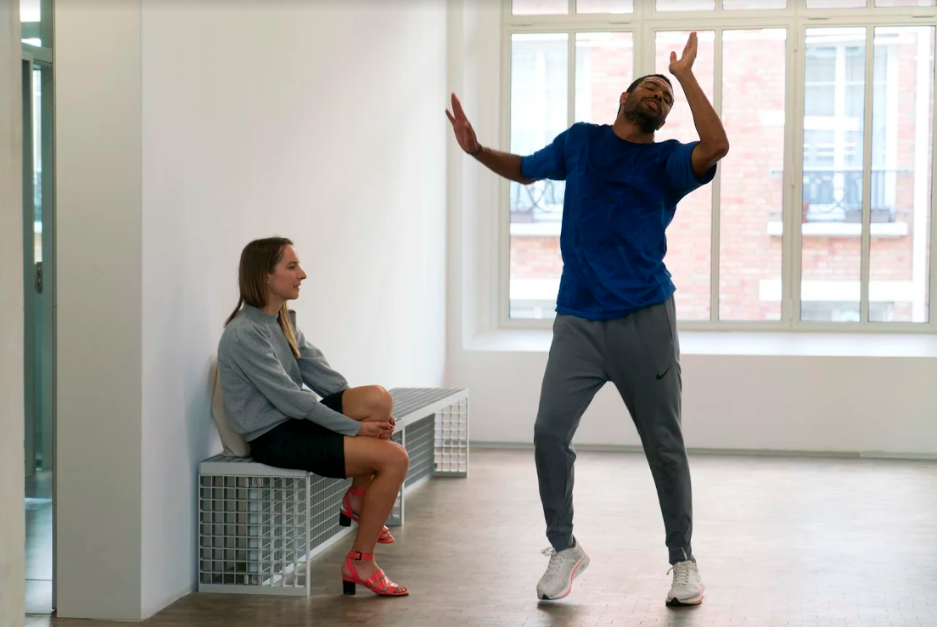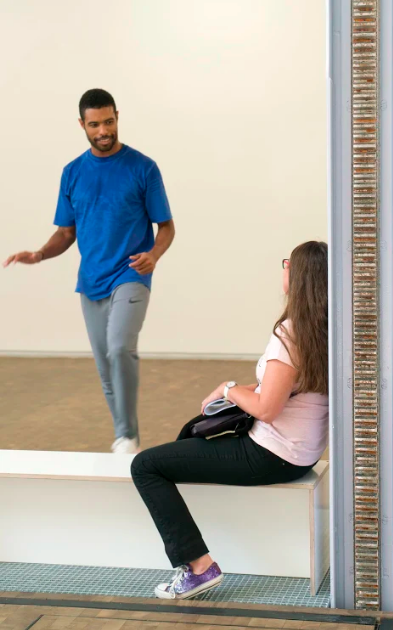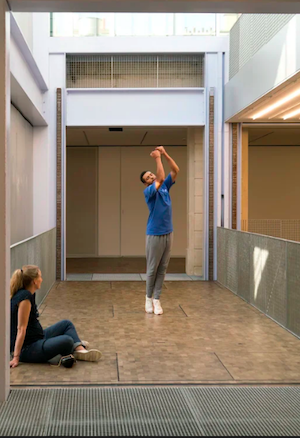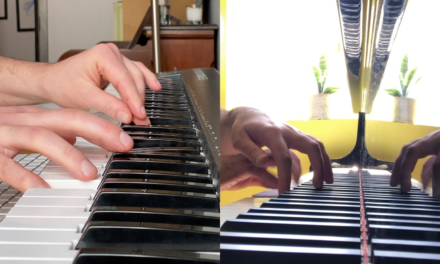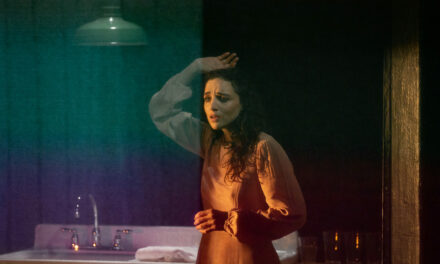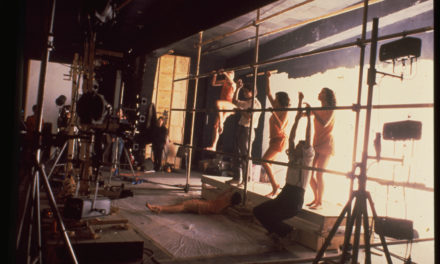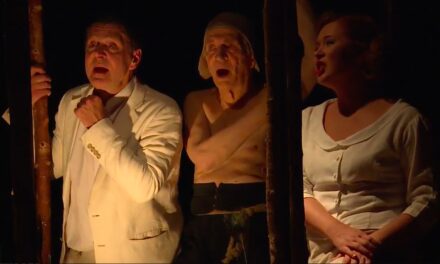In order to analyze the concepts “skill”, “artistry” and “virtuosity” within the performing arts, I need to unpack their meanings. If they imply spending a long time with a practice or task and formalizing it (and oneself) within a given institutional framework, then the work spent immediately becomes labor, recognized as part of an economic system to which the art world belongs. Moreover, the work gains a certain value. But the transition from “any work”, to a valuable skill isn’t that clear – the distinction between “work” and “labor” in the context of art is tricky. While work can be understood as an uncountable effort, labor is the work spent on a specific task, often including monetary exchange: a salary. Artists are seldom paid for their labor, but rather for the artwork produced, meaning that the (uncountable) work spent when producing this artwork resides in a conflictual gap between labor and work. When it comes to performance and dance, the living labor often equals the live work, further blurring the economic lines of contemporary production. Virtuosity must be understood through this gap, which with this essay, I will try to unfold.
Looking back at the history of aesthetics, “work” (in terms of “craft”) has been excluded from the writings of Kant, Baumgarten, and others. The reason is that the emerging understanding of aesthetic autonomy (the autonomous encounter with an artistic expression) in the late 1700s was developed from the point of view of what is not alive – eternally encountered by the living spectator. This means, in practice, that the living work needs to be over – or at least distanced – from the artwork presented. In the long run, this also affects what art is made present to the larger public. By the same reason, dance and the neighboring concepts choreography and performance have been excluded in art historical discussions of “work” and “art”, emerging throughout modern industrialization – although these art forms were crucial for an overall art history of the last century. Authors such as Andrew Hewitt, Bojana Cvejić and Bojana Kunst have extensively written on performance and dance in relation to work and labor from the point of view of philosophy and dance studies. With this essay, I will depart from aesthetic theory while insisting on including performance art, choreography, and dance in this theoretical framework – and approach the concepts of work and labor in the contemporary arts.
The dematerialization of art in the post-medium state
One forerunner in the art theoretical canon is American art critic Rosalind Krauss, who in her 1999 essay “Reinventing the Medium” maps the convergence of art and photography beyond the modernist paradigm of medium specificity. Invented as a supporting technique for other arts, photography was increasingly discussed in the art theory of the 1900s. It thus also became a “theoretical object” [1] or “teoretikai technai” – and then was increasingly seen as an autonomous art form [2]. In this transition, the influence of photography extended beyond its medium and art form, Krauss argues. Altering the idea of “the original” with the various copies of the photographic object – photography thus had an impact on the concept of art as such. From then on, it wasn’t only about the original resulting artwork, but about the action mediated by various media, at work. Something which in its turn both brings the thoughts to the then-nascent conceptual art, and, of course, to dance and choreography. As Krauss writes, the photographic transformation beyond the medium itself was both enacted and documented by the photographic action [3]– something that interestingly enough also speaks to modern choreography and dance, which in fact emerged parallel to photography and film, in the early 1900s. Equally to how Krauss describes photography, the dance goes beyond its own, embodied media – while extending further as choreography. Dance always both enacts and documents (within the living body), the ongoing transformation that happens within the practice – which I will get back to in terms of the false binary between work and labor in this investigation of virtuosity in dance today.
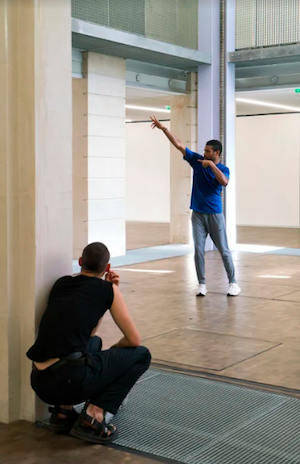
Already Unmade, Andros Zins-Browne. Courtesy of Fondation Galeries Lafayette, Paris.
In Krauss’ terms, the turn beyond the modernistic paradigm of medium specificity, which she noticed in the turnover to postmodern art – was to be called “the post-medium condition” [4]. It implies that the artwork rather than on a specific medium relied on a “technical support” based on various media [5] that form an infrastructure altogether. In the case of body-based art, this technical support equals the performing body at work – which immediately makes dance and choreography interesting objects for Krauss’ theoretical endeavor. Yet she didn’t give much attention to the then flourishing field at the time, and the same could be said about her contemporary Lucy Lippard – who together with John Chandler co-authored the seminal essay “The Dematerialization of Art” in 1969. In it, they describe how contemporary artists in the 60s and 70s started to use the studio as a site for conceptual endeavors, after which open-ended works emerged beyond a strict understanding of a modernist, strictly defined artifact in a gallery.
The same tendency was seen in the field of dance and performance during this period, where an interwoven use of the studio, the theatre space, and the public space, allowed for new uses of the organic body of the dancer and the social body of interrelated choreographic practices – as technical support. This was not only the case for the famous Judson Church dance experiments in New York but equally present in post-war Japan, the Soviet Union, Eastern Germany, and former Yugoslavia. While de-skilling and chance procedures were central for those practices, a forging of fields such as choreography, sculpture, and music allowed for interdisciplinary works where precisely “work” and “artwork” merged as one. If the studio became the object of study for visual artists (countering the practical need for outside presentation) – as argued by Lippard and Chandler – the social body and the public sphere itself became the site of study for dancers.
Andros Zins-Browne’s Already Unmade
Returning to the concept of skill, we also need to unpack the concept from a contemporary point of view. If the dematerialization of art in the state of a post-medium condition interlinks artistic work and artworks (as the case has always been in dance), we need to critically rethink the work being extracted in a contemporary society of performance (of the self). In his ongoing work Already Unmade (since 2017), American choreographer and dancer Andros Zins-Browne applies an inverted rehearsal onto finalized “products” – dance works – that he has been performing over the years. Stored as bodily memories, Zins-Browne tries to undo [6] these traces, while engaging with them in a particular manner.
The performance Already Unmade takes the shape of an open-ended choreography where Zins-Browne moves around in a naked space, approaching the surrounding audience (that freely walks in and out) one after the other, saying “welcome back”. “Back” to the piece, that is. Or rather, the various pieces that are stored within his body. From gesture to singing tunes and words, the audience witnesses what seems to be a warm-up or a rehearsal of innumerable memes: looped floating signifiers that altogether create a new system of signification, not yet revealed for the spectator. Or even, for the performer himself. As he repeats, “This is a rehearsal”, the loop goes in and out of sync. Constantly altered within each repetition, actions are made anew from within combinations and simultaneously linked back to the attentive audience, with the help of the dancer’s social attention toward them.
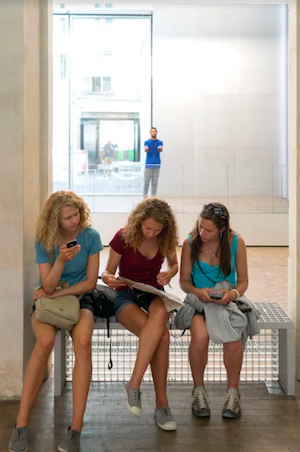
Already Unmade, Andros Zins-Browne. Courtesy of Fondation Galeries Lafayette, Paris.
Re-linking to Yvonne Rainer’s old saying – that the body “remains the enduring reality” [7] – Zins-Browne lets the layered artworks that this “reality” entails, undo each other – while simultaneously being restored and rebooted in the present moment of his physical labor. Thus, the enduring realities of the artworks are contested from within the working body: the living artist himself. Similarly, Zins-Browne does not allow the work to be limited by a traditional timeframe for a piece of dance (durational or not). Presented in an open-ended gallery space, sometimes with several bodies involved, Already Unmade simply has no beginning nor any end. Yet it is an “artwork” in the very negation of the concept. Lasting for many hours, even sometimes during several days (as often in the case of an exhibition of visual arts), the work is repeated within, not around – as in the production cycle of contemporary capitalism. Rather does each fragment of the piece loop within the rehearsal of this bodily memory – so that the artwork as a whole cannot have concepts such as endings or beginnings (which a repetition demands). In Zins-Browne’s own take, this means that he is “structuring the piece so that it cannot be structurally dismantled” [8]. With dismantling, he refers to the alienation of worker from a product, as often occurs in surplus circulation. In other words, Zins-Browne stays at work to not let the artwork proliferate in the logistical black hole of the Artworld.
For Zins-Browne, Already Unmade is about precisely avoiding the tendency of dance to repeatedly restore given frames from a repertoire [9] – as when workers in an assembly line inherently produce the same product that they just lost hold of, increasingly alienated from it. For dance and performance, the assembly line implies producing and exhibiting institutions. Neglecting this logic, Already Unmade instead restores layers of work and gives them an internal, autonomous value (different from the momentary surplus value given in external circulation, such as when a ticket is sold). Thus, the piece enables an autonomy of dance from within the artist’s ongoing work – as opposed to the Kantian notion of an objective, outside spectator’s point of view. Lippard and Chandler call the dematerialized art “post-aesthetic only in its increasingly non-visual emphases” [10]. For contemporary dance and performance, the non-visual paradigm is rather manifested in the fluent frame between work and worker, as Zins-Browne’s choreography. In his case, the post-aesthetic paradigm of art emerges circularly.
Virtual bodies as digital files
In many ways, Zins-Browne’s work reflects the dynamics of online dematerialization. A few years ago, artist and writer James Bridle introduced the notion of “the new aesthetics” [11], marking ever-changing, sensible encounters of contemporary art, interwoven with digital online media. Even though this tendency has emerged during the last two decades of the internet, Bridle’s recognition of the multimedia outputs and their receptors relate closely to how Zins-Browne describes his renewed encounters with the works that he has already performed – encounters that change both for himself and for the spectators. Thus, his approach to the working body develops Rainer’s old statement further, to internalize the “online dematerialization” within the “enduring reality” of the working body. Additionally, Zins-Browne describes this endurance in terms of the various “bodies” that he has stepped in and out of, as a dancer. Thus, it is not only his body that lasts but all bodies that his working one has ever produced. He calls these virtual bodies “digital files” that partly have been corrupted over time. When rehearsing these “backwards” [12] –– starting with a finished “choreographic object” and attempting to rehearse its unmaking, Zins-Browne allows these “objects” to overlap and interrupt each other, so that they are neither fulfilled nor fully dismantled.
Turning back to the initial question of virtuosity, it is clear that Zins-Browne has developed a skill to stay with the work, at work. In other words, it’s a skill against the alienation of skill, as within a modern capitalist production of surplus-value. And as the digital files move around in Zins-Browne’s laboring body, “a digital folding process” [13] appears––where memory is collected and processed by software with need of constant updates, which the files sometimes cannot follow. Older files are partly read, and on some occasions, they convert to useless storage. Still consuming storage space, they remain on the hard drive – a space that Zins-Browne makes visible when engaging with his working body as a whole. Working from memory, remixing each of these files of multiple ages and bytes, the linear time that normally governs time-based artworks- from idea to finished product- is bent. As a consequence, the artwork’s timeframe is re-worked from inside a non-linear, heterogenous temporality. This engagement can be related to how the German philosopher Theodor Adorno once proposed an understanding of art’s autonomy [14] different from the Kantian one. According to Adorno, art’s autonomy depends on a non-market driven sensible encounter between artist and artwork – as well as between artwork and an outside spectator (making it an aesthetic autonomy). Engaging with the components of the work so that they come together (as in the case of Zins-Browne’s dancing), the work is reconnected to their social surrounding (from which it according to Adorno also withdraws when becoming art, and in this case: the old artworks stored in Zins-Browne’s body).
In the case of Zins-Browne, the score of the artwork (Adorno draws from musical notation) allows for such an autonomy since it demands engagement of both practitioner and spectator when reconnecting the inside components to the outside social sphere, without an abstract interest of the market as the main reason for this relation. For Zins-Browne, this engagement is internalized within Already Unmade, as its methodology departs from such a reconnection in-between the “files” in the working body. Thus, Already Unmade as artwork(s) is encountered both from within – by the artist himself – and from the surrounding audience (if there is any). Not only depending on the surrounding social sphere but the piece thus also internalizes the public sociality as part of this loop of engaging files. A sociality which according to Adorno is essential for the work to emerge in the outer world [15]. As a consequence, Zins-Browne lets dance work and artwork merge into an engagement with the social as an “enduring reality” of art, as living work. Turning back to Lippard and Chandler, the very collapse of the institutional (and thus economic) separation between studio and exhibitory space collapses – as once artist, Daniel Buren suggested when underscoring the problem that comes with the extractive procedure when transporting a work form the studio and to an outside exhibition space [16].
Productive and unproductive artistic labor
In her recent book Working Aesthetics (2019), art theoretician Danielle Child writes that “while art itself may remain relatively autonomous or distinct from the mainstream economic market, the sites of its display are inherently tied to the economic base through the employment of wage laborer’s.” [17] It was toward this site of display that Adorno directed his main critique, since artworks there may emerge as artifacts of consumption, just like any other product. Artistic work is equally involved in this market, as soon as artists are waged for their labor. The tricky thing when it comes to art is, explains Child, is that the artist is often not waged for the labor but for the work that enables the product – the artwork. And by the same reason, Kant et al. could easily ignore the production process and the living worker behind a piece of art. This separation makes the artist equal to the traditional understanding of a craftsperson who, according to Karl Marx “is a seller of commodities and not of labor” [18] (while remaining unpaid for the work behind it). When sold, the artwork “has not been alienated from its maker, that is, labor has not confronted the handicraftsman as a separate power”. Accordingly, Child states that artistic work can be understood as “both unproductive – when the artist freely creates and then sells the work – or productive” [19]. What makes it productive or not is, Child continues, how it is distributed – how it takes place, how it is perceived and, perhaps, consumed: ”The unproductive aspect does not relate to a quality inherent in the type of work being undertaken; it lies in how the labor is purchased and what it produces.” [20]
When it comes to artworks that are embodied by the working artist, this distinction is, as mentioned earlier, more complicated. Avoiding institutional distribution and in the long run, alienation – Zins-Browne distributes his work along with the work, when performing Already Unmade. This is underscored by the fact that he doesn’t consider Already Unmade a practice of his, but rather a practice of the work – the artwork. Something which in the long run questions the imperative of producing “a new” work – and which inherently complicates the Marxist distinction between labor, work, and artwork, in dance. By the same reason, it becomes harder to define virtuous capacities of the work, where extractive mechanisms of circulated surplus – as in choreography per se – aren’t subsuming the dancer. But in the case of Already Unmade, we might find alternatives to this conflictual glossary: through the working body of the dancer; the artwork is at work, in both a productive and a reproductive sense. In other words, Already Unmade entails the skill not of the dancer, but of the piece(s), the files, themselves – to sustain – upheld by the infrastructural labor of the dancer: Zins-Browne.
In a conversation, Zins-Browne explained to me that he attempts to save the work from disappearance: “How can I keep working with it – how can I stay within the work?” [21] Turning back to Child’s reference to Karl Marx, it could be argued that Zins-Browne enacts a reproductive work that is precisely productive – since he disables the external consumption of the work while simultaneously making it coming into being. By recirculating the ”digital files” within his working body, he upholds their activity. Not to refine or complete these, but to simply keep them from disappearing. It’s a circulation of virtuosity without alienating extraction of this work – without an outside measurement of surplus-value of this very artistry. It’s a skill against skill.
[1] Rosalind E. Krauss, “Reinventing the Medium”. Critical Inquiry, 25:2, “Angelus Novus”: Perspectives on Walter Benjamin” (Chicago: The University of Chicago Press, 1999), 292.
[2] In a Kantian sense this means that its craft was to be distinguished from the forerunning labor that made it possible. As a reference, this wasn’t the case for dance, which was and still is the opposite of such demands, and this simply was left out of the early history of aesthetics (which also had a large impact of today’s institutions for art theory and practice.)
[3] Ibidem.
[4] Krauss, Rosalind. “A Voyage on the North Sea.” Art in the Age of the Post-Medium Condition. London: Thames & Hudson, 2000[1999].
[5] Ibidem.
[6] “Instead of rehearsing towards a finished product I am rehearsing from a finished product to try to undo it”, conversation with the artist, 10 April 2018.
[7] Yvonne Rainer, “The Mind is a Muscle” in Tulane Drama Review Vol. 10, issue 2 (Winter, 1965): 178.
[8] Conversation with the artist, 10 April 2018.
[9] Ibid.
[10] Lucy R. Lippard and John Chandler, “The Dematerialization of Art”. (1967-68), in Conceptual Art: A Critical Anthology, ed. Alexander Alberro and Blake Stimson. (New York: MIT Press, 1999).
[11] https://jamesbridle.com/works/the-new-aesthetic (access: June 25, 2019).
[12] Conversation with the artist, 10 April 2018.
[13] Ibid.
[14] Adorno, T. W. Aesthetic Theory. ed. Adorno, G, and Tiedemann, R. (London, New York: Continuum, 1970).
[15] Ibid.
[16] “The work thus falls victim to a mortal paradox from which it cannot escape, since its purpose implies a progressive removal from its own reality, from its origin.” – Daniel Buren and Thomas Repensek,” The Function of the Studio Author(s)”, October 10, (New York: The MIT Press 1979), 53.
[17] Working Aesthetics, s. 7.
[18] Danielle Child, WorkingAesthetics. Labour, Art and Capitalism. (London: Bloomsbury Publishing), 5.
[19] Ibid.
[20] Ibid.
[21] Conversation with the artist, 10 April 2018.
This article was originally posted at e-tcetera.be and has been reposted with permission. To read the original article, click here.
This post was written by the author in their personal capacity.The opinions expressed in this article are the author’s own and do not reflect the view of The Theatre Times, their staff or collaborators.
This post was written by Frida Sandström.
The views expressed here belong to the author and do not necessarily reflect our views and opinions.

